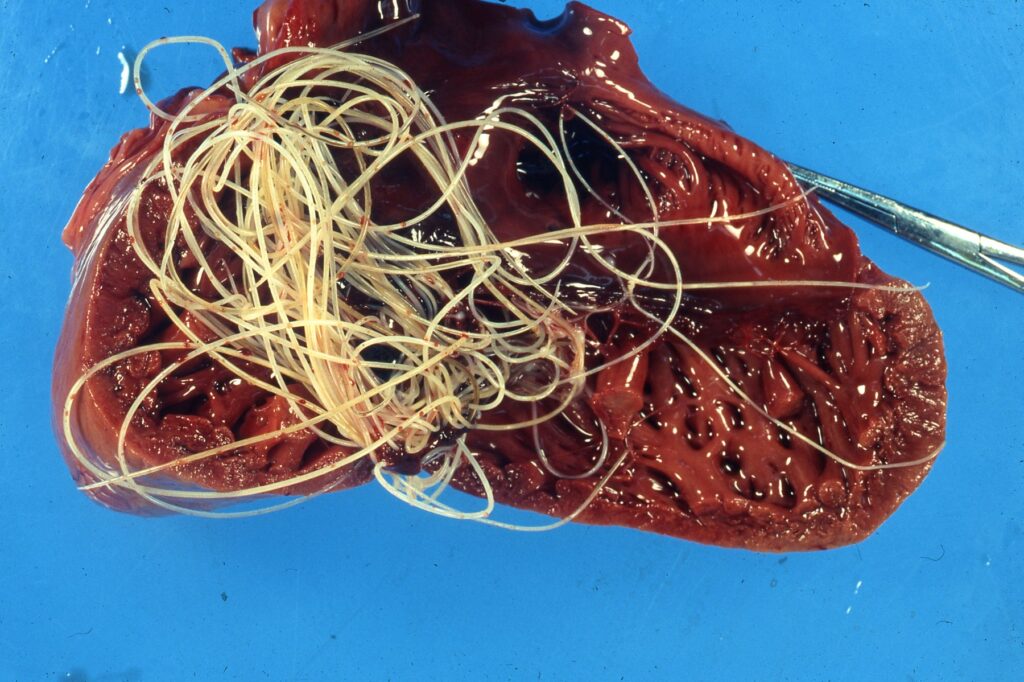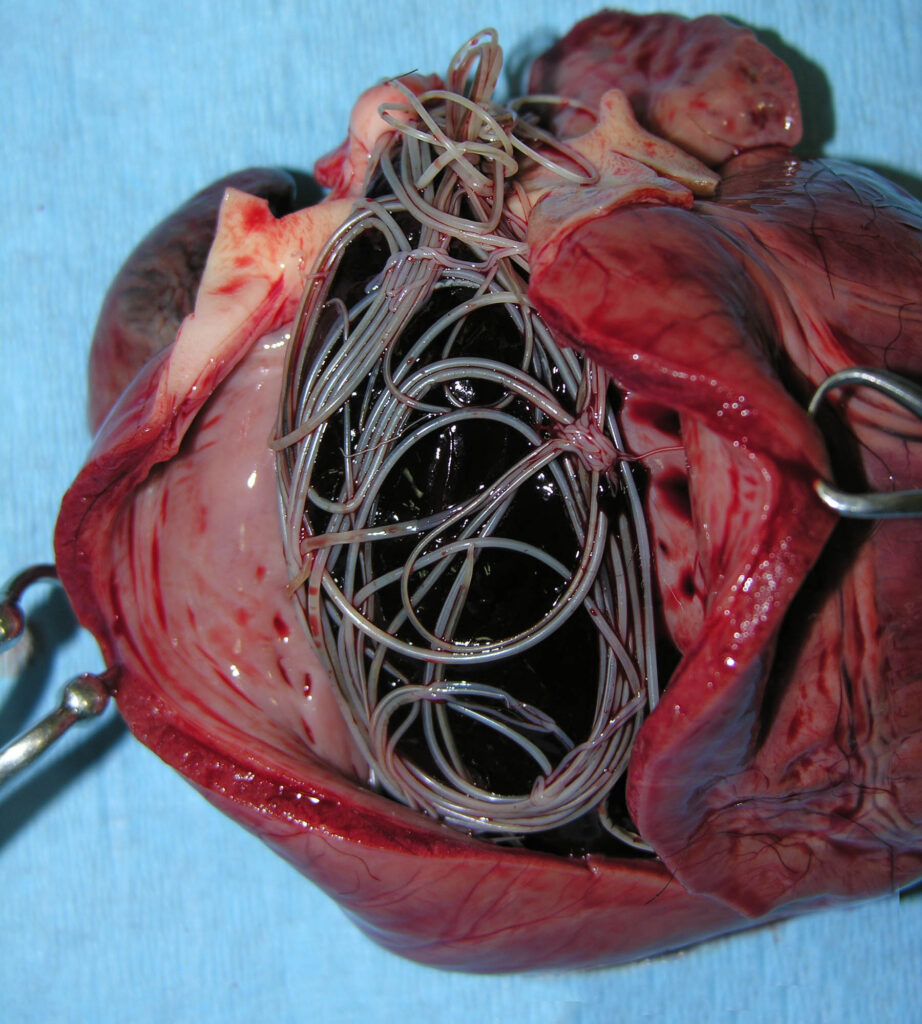Today’s path rounds are on 𝐡𝐞𝐚𝐫𝐭𝐰𝐨𝐫𝐦!
𝐖𝐡𝐚𝐭 𝐢𝐬 𝐢𝐭?
𝐇𝐞𝐚𝐫𝐭𝐰𝐨𝐫𝐦 is a parasitic disease caused by a roundworm called 𝐃𝐢𝐫𝐨𝐟𝐢𝐥𝐚𝐫𝐢𝐬 𝐢𝐦𝐦𝐢𝐭𝐢𝐬. These worms like to live in the heart (hence the name of the disease) and in the 𝐩𝐮𝐥𝐦𝐨𝐧𝐚𝐫𝐲 𝐚𝐫𝐭𝐞𝐫𝐲 (major vessel going from the heart to the lungs), and can get up to 30cm long!
𝐖𝐡𝐨 𝐠𝐞𝐭𝐬 𝐢𝐭?
We typically think of this disease in dogs, however technically many different mammals can get infected. Most importantly, cats and ferrets can get infected, which can be fatal in these species.
𝐖𝐡𝐚𝐭 𝐜𝐚𝐮𝐬𝐞𝐬 𝐢𝐭?
Heartworms are a round worm that can be found in tropical and subtropical regions primarily, although they are starting to be found more commonly in temperate areas of North America. Dogs are considered the 𝐫𝐞𝐬𝐞𝐫𝐯𝐨𝐢𝐫 of this disease, meaning that they are the source of essentially every infection!
It is the adult stage of these worms that actually lives in the heart and pulmonary artery, where they produce 𝐦𝐢𝐜𝐫𝐨𝐟𝐢𝐥𝐚𝐫𝐢𝐚𝐞 (larvae) that are released into the bloodstream. A mosquito feeding on the animal will pick up these microfilariae and transmit them to the next animal they feed on, spreading the infection.
𝐖𝐡𝐲 𝐢𝐬 𝐭𝐡𝐢𝐬 𝐚 𝐩𝐫𝐨𝐛𝐥𝐞𝐦?
This may come as a surprise, but your heart isn’t really meant to have worms living in it! The valves that the worms snake through don’t close properly, causing the heart’s chambers to become leaky, and the mass of worms blocks normal blood flow through the pulmonary artery, causing 𝐡𝐲𝐩𝐞𝐫𝐭𝐞𝐧𝐬𝐢𝐨𝐧 (high blood pressure) in that vessel. Typically these severely affected dogs will develop signs of cardiac dysfunction, and this dysfunction can progress to congestive heart failure.
These worms can also form 𝐭𝐡𝐫𝐨𝐦𝐛𝐨𝐞𝐦𝐛𝐨𝐥𝐢, where their attachment to the heart wall fails and they end up in the bloodstream. Once they are in the vessels, they will be pushed along until they reach a vessel they are too large to pass through, causing a blockage. Tissues downstream of that vessel will no longer receive nutrients and oxygen, causing 𝐧𝐞𝐜𝐫𝐨𝐬𝐢𝐬 (cell death). Not good!
𝐖𝐡𝐲 𝐢𝐬 𝐭𝐡𝐢𝐬 𝐝𝐢𝐬𝐞𝐚𝐬𝐞 𝐬𝐨 𝐜𝐨𝐧𝐜𝐞𝐫𝐧𝐢𝐧𝐠 𝐢𝐧 𝐜𝐚𝐭𝐬 𝐚𝐧𝐝 𝐟𝐞𝐫𝐫𝐞𝐭𝐬?
Because these worms are quite large, and these critters (and their hearts!) are quite small, even small numbers of worms can cause heart failure.
Additionally, the consequences of a worm thromboembolus are even more severe, because these worms will block “larger”, more important vessels in these species than they normally would in a dog. For example, in cats, even one adult heartworm forming an embolus can block off major vessels in the lungs, causing severe respiratory stress and potentially even death.
𝐇𝐨𝐰 𝐢𝐬 𝐢𝐭 𝐝𝐢𝐚𝐠𝐧𝐨𝐬𝐞𝐝?
This disease can be diagnosed in a couple of ways, such as detecting 𝐚𝐧𝐭𝐢𝐠𝐞𝐧 (parts of the worm) or antibodies against the worm in the blood. But probably the most interesting way is doing a 𝐛𝐥𝐨𝐨𝐝 𝐬𝐦𝐞𝐚𝐫, where a drop of blood is looked at under a microscope. On this smear, you can actually see the little microfilariae swimming around in the blood! Wild.
𝐇𝐨𝐰 𝐢𝐬 𝐢𝐭 𝐭𝐫𝐞𝐚𝐭𝐞𝐝?
This disease is treated using 𝐚𝐝𝐮𝐥𝐭𝐢𝐜𝐢𝐝𝐞𝐬 (adult-killing drugs) that specifically target the worms hanging out in the heart. This treatment can be risky however, because dying adults can form thromboemboli as mentioned previously. In very severe infections, surgical removal of the worms is ideal to hopefully reduce this potential complication of treatment.
𝐇𝐨𝐰 𝐢𝐬 𝐢𝐭 𝐩𝐫𝐞𝐯𝐞𝐧𝐭𝐞𝐝?
Prevention is key for this condition! Giving routing doses of antiparasitic medications, recommended by your veterinarian, can kill the adult and microfilarial stages to prevent them from developing into adults. If you live in an area where heartworm is present, it is absolutely crucial to have your dog (and cat!) on a preventative plan to keep these nasty worms at bay.
𝐏𝐡𝐨𝐭𝐨𝐬
1) An example of a microfilaria in a blood smear! The purple dots nearby are blood cells, to give you a sense of how big these larvae are!
2-6) Adult heartworms in their favourite location. Anybody want some spaghetti? ![]()
![]()
𝐒𝐨𝐮𝐫𝐜𝐞𝐬
Maxie, G. Jubb, Kennedy and Palmer’s Pathology of Domestic Animals, Volume 3. Sixth Edition.
Atkins, C. Heartworm disease in dogs, cats and ferrets. Merck Vet Manual 2014.
Photos 1-7 © Noah’s Arkive contributors Leathers, Niyo, Cho, Jakowski, Crowell, Rech, Kesdangsakonwut licensed under CC BY-SA 4.0.











